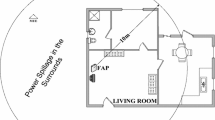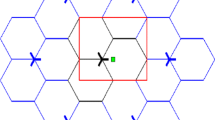Abstract
The paper discusses femtocell identification aspects in mobile networks such as long-term evolution (LTE) and LTE-advanced. Femtocells, or femto access points (FAPs), are new-class of base stations in addition to existing macro, microcells. Unlike these cells, femtocells implement automatic configuration principles. One of the main parameters in the automatic configuration process is among others an physical cell identifier. By considering two FAP deployment models, we discuss collision and confusion issues, which affect the proper physical cell id allocation. The first model represents a random deployment of FAPs within a (rural) macrocell area, whereas the second one, called dense urban model, constitutes placement of FAPs in a built-up area. The given study serves for the better understanding of interrelations between differently placed FAPs in term of collision and confusion events, and the obtained results can be used as a basis when designing an algorithm for automated assignment of physical cell identifier.















Similar content being viewed by others
References
IEEE Comsoc. (2015). Ten trends that tell where communication technologies are headed in 2015. January 2015. Available at www.comsoc.org.
UMTS Forum. (2015). 3G/4G subscriptions pass 3 billion milestone. In UMTS forum.
GSMA. (2014). Understanding the internet of things. In GSMA.
UMTS Forum. (2011). Mobile traffic forecasts 2010–2020 report. Report 44, UMTS Forum.
CISCO. Indoor small cells: A guide to mission critical communication. Available at http://www.cisco.com/c/dam/en/us/solutions/collateral/service-provider/small-cell-solutions/smallcells-infographic.pdf.
Small Cells Forum. Small cells: Elevator pitch. Available at http://www.smallcellforum.org/about/about-small-cells/elevator-pitch/.
Small Cells Forum. Small cells: Definition. Available at http://www.smallcellforum.org/about/about-small-cells/small-cell-definition/.
3GPP TR 36.300 V13.1.0. (2015). Evolved universal terrestrial radio access (E-UTRA) and evolved universal terrestrial radio access network (E-UTRAN) overall description; stage 2. In 3GPP TSG RAN.
3GPP TR 32.816. Study on management of evolved universal terrestrial radio access network (E-UTRAN) and evolved packet core (EPC). In 3GPP TSG RAN.
Feng, S., & Seidel, E. (2008). Self-organizing networks (SON) in 3GPP long term evolution. Germany: Nomor Research GmbH.
3GPP TS 36.211 V12.7.0. (2015). Physical channels and modulation. In 3rd Generation partnership project; technical specification group radio ccess network; evolved universal terrestrial radio access (E-UTRA).
3GPP TS 36.133. (2014). 3GPP technical specification group radio access network. In Evolved universal terrestrial radio access (E-UTRA), 3rd generation project partnership on requirements for support of radio resource management (release 12).
3GPP TR 36.902. (2010). Self-configuring and self-optimizing network (SON) use cases and solutions. In 3GPP TSG RAN.
Mathar, R., & Niessen, T. (2000). Optimum positioning of base stations for cellular radio networks. Wireless Networks, 6(6), 421–428.
Fewell, M. P. (2006). Area of common overlap of three circles. Technical Report DSTO-TN-0722. Maritime Operations Division, Australian Government, Department of Defence.
Librino, F., Levorato, M., & Zorzi, M. (2009). An algorithmic solution for computing circle intersection areas and its applications to wireless communications. In 7th International symposium on modeling and optimization in mobile, ad hoc, and wireless networks (pp. 1–10).
Nourani, F., & Jamali, M. (2010). Improved circles intersection algorithm for localization in wireless sensor networks. In 2010 11th ACIS international conference on software engineering artificial intelligence networking and parallel/distributed computing (SNPD) (pp. 129–133).
Lei, F., Wenliang, D., & Peng, N. (2005). A beacon-less location discovery scheme for wireless sensor networks. In INFOCOM 2005, Proceedings IEEE on 24th annual joint conference of the IEEE computer and communications societies. (Vol. 1, pp. 161–171).
Zaidi, M., Tourki, R., & Ouni, R. (2010). A new geometric approach to mobile position in wireless LAN reducing complex computations. In 2010 5th International conference on design and technology of integrated systems in nanoscale era (DTIS) (pp. 1–7).
3GPP. (2008). 3GPP R3-080376, SON use case: Cell Phy ID automated configuration. In 3GPP.
3GPP. (2008). 3GPP R1-082747, summary of options to extend the PCI space. In 3GPP.
Sungoh, K., & Neung-Hyung, L. (2011). Virtual extension of cell IDs in a femtocell environment. In 2011 IEEE on wireless communications and networking conference (WCNC) (pp. 428, 433, 28–31).
Bandh, T., Carle, G., & Sanneck, H. (2009). Graph coloring based physical-cell-ID assignment for LTE networks. In IWCMC (pp. 116–120).
Bandh, T., Carle, G., Sanneck, H., Schmelz, L. C., Romeikat, R., & Bauer, B. (2010). Optimized network configuration parameter assignment based on graph coloring. In 2010 IEEE on network operations and management symposium (NOMS) (pp. 19–23).
Furqan, A., Olav, T., Matti, P., Juha-Matti, K., Chia-Hao, Y., & Miko, A. (2010). Distributed graph coloring for self-organization in LTE networks. Journal of Electrical and Computer Engineering, 2010, 1–10.
Yanguang, L., Wenjing, L., Heng, Z., & Weihao, L. (2010). Graph based automatic centralized PCI assignment in LTE. In 2010 IEEE symposium on computers and communications (ISCC) (pp. 919–921).
Yi, W., Jiang, H., Ye, W., & Dongmei, Z. (2010). Physical cell identity self-organization for home eNodeB deployment in LTE. In 6th International conference on wireless communications networking and mobile computing (WiCOM) (p. 1).
3GPP. (2008). 3GPP R2-084563. In New solution for CSG-cell identification. 3GPP.
Qualcomm Research. (2013). Neighborhood small cells for hyperdense deployments: Taking HetNets to the next level. February 8 2013. Available at https://www.qualcomm.com/media/documents/files/qualcomm-research-neighborhood-small-cell-deployment-model.pdf.
Author information
Authors and Affiliations
Corresponding author
Additional information
Publisher's Note
Springer Nature remains neutral with regard to jurisdictional claims in published maps and institutional affiliations.
Rights and permissions
About this article
Cite this article
Sedlacek, M., Bestak, R. Evaluation of Random Physical Cell Id Assignment to Femtocells Under Dense Cell Deployment. Wireless Pers Commun 104, 753–769 (2019). https://doi.org/10.1007/s11277-018-6049-y
Published:
Issue Date:
DOI: https://doi.org/10.1007/s11277-018-6049-y




